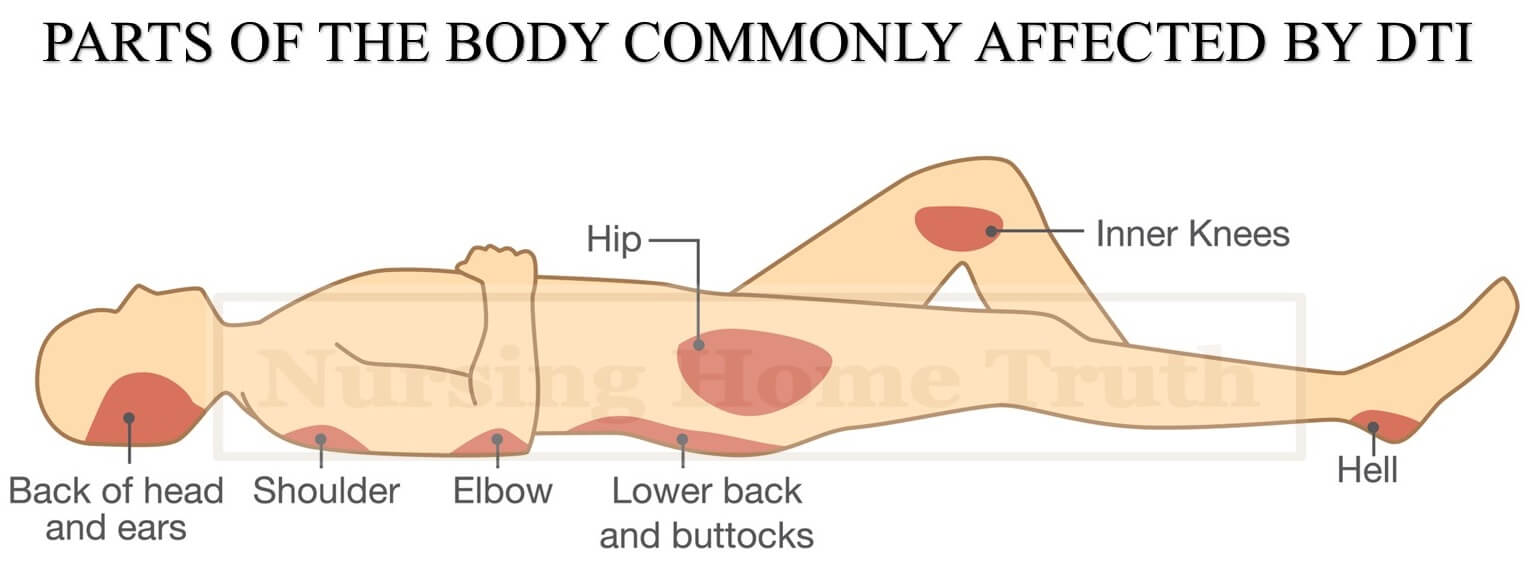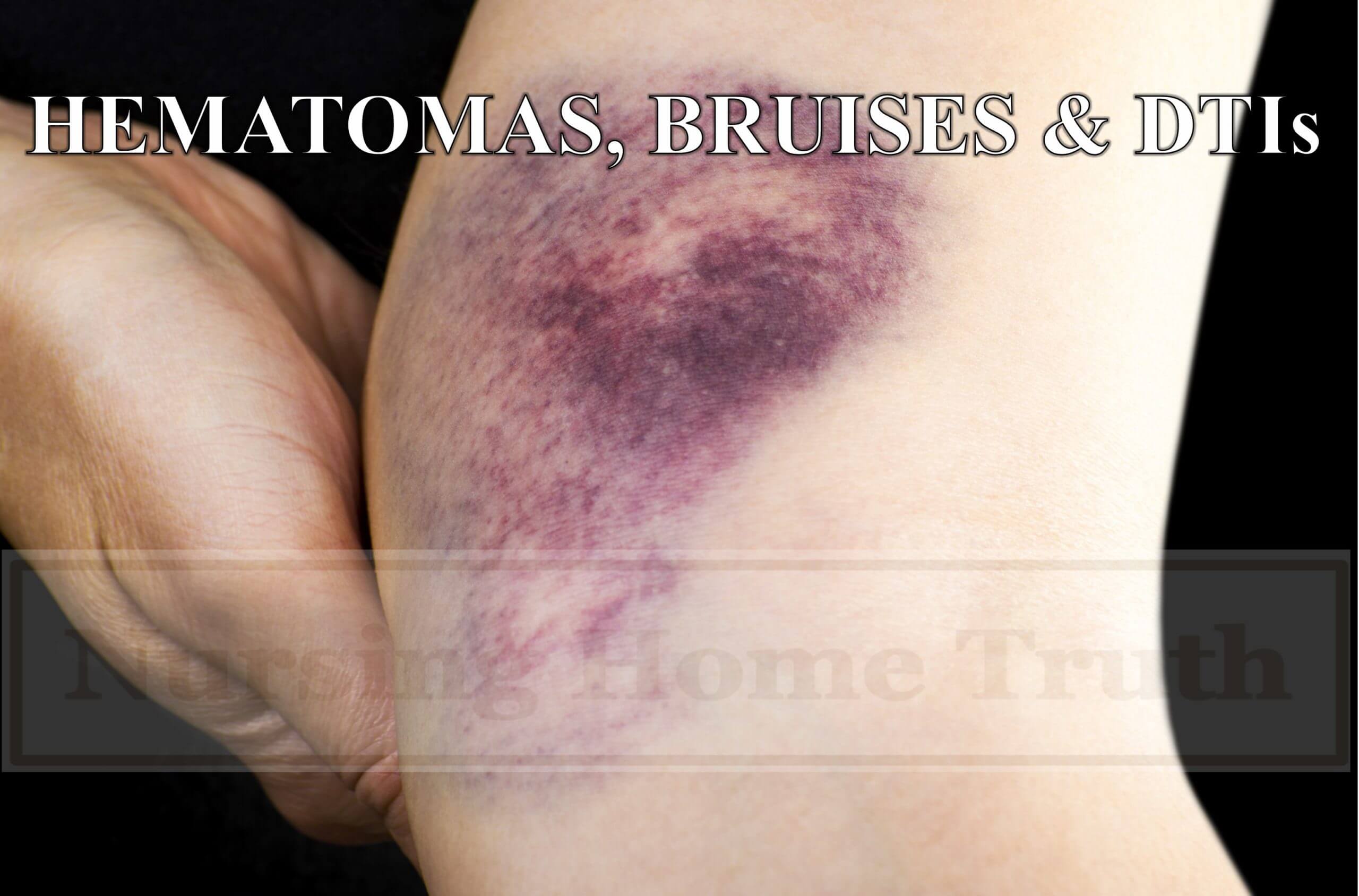Article Updated: November 14, 2023
Deep Tissue Injury Treatment
DTI injuries are big red flags. These are the predecessor to a pressure wound. If a patient has a DTI, I immediately start wondering:
◊ Are there staffing issues in the facility?
◊ Is the patient being turned and repositioned?
◊ Is the patient facing abuse or neglect?
It is imperative that anyone with a deep tissue injury receive timely and adequate deep tissue injury treatment, or else that DTI will fester into something much worse. Below, I’ll walk you through the 101’s of deep tissue injury treatment, and explain how that treatment can impact settlement values when litigating DTI claims.
Clickable Table of Contents
Deep Tissue Injury Treatment
1 – Deep Tissue Injuries Defined
2 – Deep Tissue Injury Treatments
3 – Limitations in DTI Treatments
4 – How Deep Tissue Injury Treatments Affect Settlements
5 – Deep Tissue Injury Treatment Q&A
6 – Deep Tissue Injury Lawyer
Resources
7 – Supporting Literature, Citations & Research
8 – About the Author
9 – Legal Help in Maryland & Nationally
Deep Tissue Injuries Defined
Deep tissue injuries, also known as DTI, are injuries that affect the skin and flesh of an individual in specific parts of the body. While it can affect many parts of the body, it mostly affects the heels, buttocks and sacrum.

This difficulty lies in the fact that the deep tissue areas that are hurt cannot be seen with the naked eye and the symptoms that something is wrong are often confused with less serious conditions.
These injuries cause many symptoms including the skin and flesh area affected to become mushy, warm or cool to the touch or discolored. Identifying these symptoms on darker skin is even more difficult which leads to even worse identification of the problem.
When deep tissue injury treatments are delayed there are more disastrous outcomes for patients who suffer from a DTI. When this happens, a DTI can transform into more serious skin conditions that can turn into life-threatening conditions.
A DTI is often confused with other conditions like bedsores and while they are similar, the main thing to remember about a DTI is that it usually has skin that is still intact but shows signs of bruising and discoloration whereas the latter will have broken skin.
Deep Tissue Injury Treatments
Current deep tissue injury treatments will rely heavily on what kind of DTI an individual has. There are more than one kind of DTI and some of the more common symptoms used in diagnosis are:
◊ Calciphylaxis: A vascular calcification and skin necrosis
◊ Bruises: Collection of blood under the skin resulting from trauma
◊ Hematoma: Purpose nodules of clotted blood under the skin

Prevention is still key and many similarities exist between the treatment of DTIs and other skin conditions.
Some recent studies have suggested that deep tissue injury treatment can include topical methods like the use of silver preparations and topical phenytoins.
Like other skin conditions, it has been suggested that constant movement of patients who are bedridden and superior skincare and nutrition can help to ensure a DTI does not occur.
In severe cases, there will be the use of forceful removal of tissue that seems to be necrotic but even in these cases, there needs to be careful attention paid to saving any stable skin in the surrounding area.
Another major aspect of the treatment of a DTI is to ensure that there is wound management to help control the spread and acceleration of the DTI in any new directions. To do this, a combination of methods can be used including:
◊ Barriers: to protect the skin while it heals
◊ Topical Antimicrobials: Helps to ensure cleanliness of the affected area
◊ Collagen: To help with the body’s natural ability to rebuild skin
◊ Compression Wraps: Used to help reduce edema
◊ Gauze: Various dressing types can be used to ensure the wound area is clean and guarded from further infection
These are some of the more common treatments that can be used. There are various additional proactive and reactive methods that can be used to treat deep tissue injuries and each one is customized to the specific needs and urgency a patient’s medical needs.
Limitations in DTI Treatment
One of the major limitations in deep tissue injury treatment is being able to even identify the problem. In many cases, there is only the suspicion of a DTI but it cannot be confirmed.
Location of DTI Injuries & Diagnosis
The reason for this inability is that the wounds that are a DTI are in a position within the body that cannot be accessed or easily seen. Because of this, there may be signs that a DTI is present, but these are the same signs that can come with many other injuries.
Since many DTIs do not have any open skin or wound, when there is purple or reddened skin, or a blood-filled blister, there is a tendency to assume that a DTI is present and treat the area as if it has been confirmed.
Lack of Viable Treatments
Another limitation in deep tissue injury treatment is that there are not many viable treatments available.
There is a scarcity in information, research and options with regards to DTI, and this lack of information makes it so that most deep tissue injury treatments are suggesting proactive measures to prevent a DTI, versus after the fact treatments to treat and help recovery in the case of a DTI that has already formed and become a problem.
How Deep Tissue Injury Treatments Affect Settlements
Settlements for DTI will depend on where the person got the injury, how far along the injury got and what treatment is needed for the injury. Deep tissue injury treatments tend to be painful and can last a long time without any real positive movement towards recovery.
DTI and Neglect in Treatment
In some ways, the very fact that there is a DTI is suggestive of neglect that led to the condition to start. The treatments for deep tissue injuries are often proactive ones such as constant movement of patients and immobile people, keeping skin dry and clean, avoiding dehydration, ensuring proper nutrition and vigilant early diagnosis of any signs of a DTI.
When these are not done as they should be, a DTI will develop or a benign case of DTI will get worse. The more intense a treatment regimen for a DTI, the more likely it was that the DTI was allowed to get to an advanced stage.
Treatment & Recovery in Deep Tissue Injuries
Treatment and recovery can last as long as 12 months in some cases, and when the recovery process is this long, it can affect settlements because of the damage it has on an individual’s personal life.
The settlement will furthermore be connected to the original reasons that the person was injured to start with, i.e., neglect and maltreatment on the part of caretakers, medical professionals or anyone who may have led to the individual developing a DTI.
Longer recovery also means more medical bills, and more medical bills result in more economic damages, which tend to increase settlement amounts.
Deep Tissue Injury Treatments and Medical Claims
Deep tissue injury claims in court will often face an uphill battle because tissue damage that has not physical evidence that can be documented, like photos, are challenged by attorneys. Increasing your claim related to the use of a specific deep tissue injury treatment will need there to be evidence that the treatment is related to original onset of the injury being related to neglect.
This does not mean that deep tissue injury treatment has no relation to claim values. When a treatment is severe then there can be a linking of the treatment to a claim value in deep tissue injury cases.
Treatments that are more invasive like the removal of areas of skin and flesh that are beyond repair due to necrosis can be an example of treatment that is both showing neglect in the original treatment as well as treatment that is able to make a lawsuit value higher due to severity in treatment.
Deep Tissue Treatments Q&A
Are there stages to DTIs?
DTI does not have formal stages at this time, but there has been the suggestion of stages of DTI similar to other skin conditions which would include examples like the reddened stage, the blistering stage and other stages based on how many symptoms can be identified and how severe they are.
What is the difference between a DTI and a bedsore?
A DTI is different than many similar conditions in that the DTI requires there to be closed skin, i.e. no open wound in the starting stages of the injury. A DTI is an injury that is under the skin which makes it harder to identify than a bedsore which has open wounds.
Are there viable treatments for DTIs?
Yes and no. a DTI has treatments that can be used to control and react to the injury, but there are no cure-all treatments that can help a DTI. At best a DTI tends to respond to some treatments like cleansing the wounded area and allowing it to recover with rest, but the best treatment for a DTI is prevention.
How can an sDTI be diagnosed?
Vigilant diagnosis and attention are needed in order to identify a suspected case of DTI (sDTI). In order to identify an sDTI there needs to be frequent examination of the skin and attention paid to any changes that come to the skin, especially between one area of the skin compared to another area of skin.
Deep Tissue Injury Lawyer
I personally handle tons of skin injury cases for injured victims. Specifically, I have handled over 200 pressure wound cases. Many of these clients have or had a DTI. However, a DTI alone is usually not a good reason to sue a medical provider. The reason is the economics of a medical malpractice lawsuit. A jury is unlikely to award enough in a DTI lawsuit to cover the 30-40k it would cost to litigate that claim. By the time those costs and attorney fees are paid out, you would be in the red.
For potential clients who call with a DTI concern, I advise them to monitor the injury closely. Take photographs. Write letters complaining to the doctors and nursing homes. Create a record of what is happening. If things get worse, it’s time to call a lawyer, and leading up to that you have created proof of what the negligent providers did to you or your family member.
Warmly,
Reza Davani, Esq.
State Bar No.: #1212110211
Federal Bar No.: #30168
Cellphone: (301) 922-4598
Email: reza@nursinghometruth.com
Pressure Ulcer Legal Library
Click/Tap Icons to Access Articles

Supporting Literature, Citations & Resources:
Levine, Jeffrey M. MD, AGSF, CMD, CWSP Unavoidable Pressure Injuries, Terminal Ulceration, and Skin Failure: In Search of a Unifying Classification System, Advances in Skin & Wound Care: May 2017 – Volume 30 – Issue 5 – p 200-202 doi: 10.1097/01.ASW.0000515077.61418.44
Mao CL, Rivet AJ, Sidora T, Pasko MT. Update on pressure ulcer management and deep tissue injury. Ann Pharmacother. 2010 Feb;44(2):325-32. doi: 10.1345/aph.1M315. Epub 2010 Jan 5. PMID: 20118142.
Risk Factors for Pressure Ulcers Including Suspected Deep Tissue Injury in Nursing Home Facility Residents, Advances in Skin & Wound Care: April 2016 – Volume 29 – Issue 4 – p E1 doi: 10.1097/01.ASW.0000481855.03439.78
National Pressure Ulcer Advisory Panel. Deep Tissue Injury
United States National Library of Medicine. (2016). Early Identification of Suspected Deep Tissue Injury (sDTI)
Annen, J. (2012). Community Care Pressure Injury Treatment Guideline
Fleck, C. (2006). Deep Tissue Injury: What, Why and When?
Wounds UK (2017). Recognizing, managing and preventing deep tissue injury (DTI)
Demarco, S. (2021). Geriatric Workforce Enhancement Program. Johns Hopkins University.
Montoya, L. (2020). Pressure Injuries, Deep Tissue Pressure Injury (DTPI)
Advantage Surgical and Wound Care (2020). Days to Heal Wound
The Children’s Hospital at Montefiore. (2021). Pressure Injuries Stages.
About the Author
This nursing home and medical malpractice article was written by Baltimore, Maryland nursing home attorney Reza Davani, Esquire. Mr. Davani received his Juris Doctor degree from a Tier 1 law school, the University of Maryland Francs King Carey School of Law. He received his first license to practice law from the State of Maryland’s Court of Appeals (MD State License No. 1212110211), and just four months later received a federal law license from the United States District Court for the District of Maryland (Federal License No. 30168).
Mr. Davani has been practicing law for over 10 years. He began practicing law by helping clients as a sanctioned student lawyer before receiving his law license, and second chaired his first jury trial in federal court before even graduating law school. He is a registered member of the Maryland Association for Justice (MAJ), the American Bar Association (ABA), the American Association for Justice (AAJ), and was formerly on the MAJ’s Legislative Leader’s Circle.
Mr. Davani has taken over 20 cases to trial in state and federal court, and favorably settled well over 100 cases for injured victims. He has personally helped his clients recover over $25,000,000 in personal injury, medical malpractice, and nursing home abuse settlements and verdicts in Maryland and other states. He is dedicated to fighting for justice, and welcomes the opportunity to help you.
About the Nurse Consultant
La kesha Dillard, started her nursing career in 1994 as a Home Health Aide (HHA). She enjoyed working with people so much that she earned her certification as a Certified Nursing Assistant (CNA). She attended Trocaire College and completed both (the LPN and RN) programs where she earned her LPN/RN AAS degree. She was motivated to further her education and in 2016 she received her baccalaureate degree in nursing from Daemen College Amherst, NY. In 2019 she successfully completed Chamberlain College of Nursing, Nurse Executive and Leadership program, and earned a Masters of Science in Nursing (MSN) degree.
Mrs. Dillard wanted to learn more about the business side of nursing, so she attended Devry University and received her Master of Business Administration (MBA) degree in 2023.
In 2021, she successfully completed the Vicky Millazo program where she earned her certification as a Legal Nurse consultant. She opened up her nurse consulting business in 2022 and is the proud owner, founder/CEO at Mrs. RN Consulting, LLC. La kesha has consulted and worked with many attorneys by helping them understand the medical records to get justice for their clients. She has worked at several Long-Term Care facilities (LTC), medical surge units and has several years of experience with patient care and consulting.
She is a strong advocate for patients and believes in Person-Centered Care (PCC) at all times. La kesha is also a tough upholder for staff rights, and she continues to motivate nurse entrepreneurs to further their education in nursing.
Medical Malpractice Nursing Home Abuse Lawyer Near You in Baltimore, Maryland & Beyond
I can help you anywhere in Maryland, including Allegany County, Anne Arundel County, Baltimore City, Baltimore County, Carroll County, Calvert County, Caroline County, Cecil County, Charles County, Dorchester County, Frederick County, Garrett County, Harford County, Howard County, Kent County, Montgomery County, Prince George’s County, Queen Anne’s County, Somerset County, St. Mary’s County, Talbot County, Washington County, Wicomico County, and Worcester County.
I have helped clients in over a dozen jurisdictions, including California, Delaware, District of Columbia, Georgia, Illinois, Iowa, Massachusetts, Maryland, Mississippi, New Jersey, New Mexico, New York, North Carolina, Pennsylvania, South Carolina, Washington, and Virginia.
I help injured victims nationwide in all 50 states on a case-by-case basis via Pro Hac Vice.

























